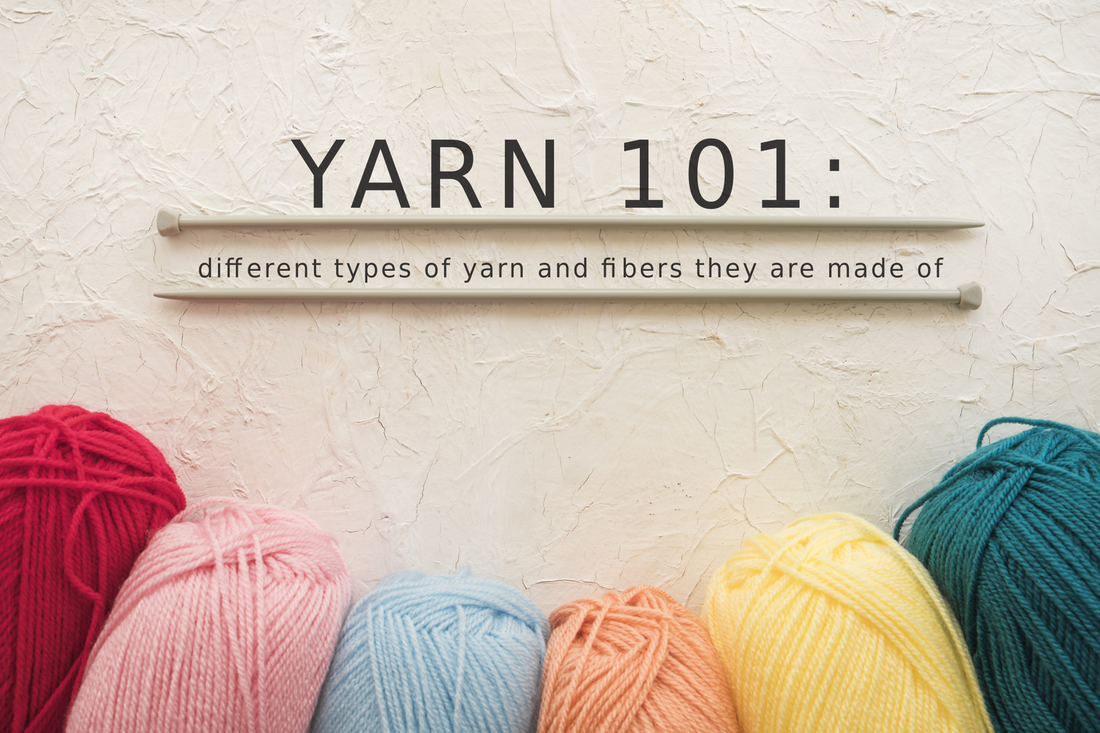
Today we're going to talk about yarn, and specifically about different types of yarn.
First of all, we can break down all yarn by fibers they are made off. So three main categories here are:
- animal fibers;
- plant fibers;
- synthetic fibers.
Let's get into the details of each of these group.
Animal fibers
Animal fibers are one of the most popular fibers to use in yarn, mostly because of their warmth and versatility. We can divide yarn made with animal fiber into groups as this:
Wool
Wool - is one of the most favorable fibers to work with because it's warm and it looks great almost in any stitch. And there are so many different wool types! Merino wool and lopi wool (both come from a sheep), alpaca wool, cashmere, angora, mohair, lamb's wool, camel wool, yak wool, different kinds of mink and other little creatures wool. Yes, there are so many to choose from! And this is definitely a good thing, because there's one huge downside to wool yarn: some people are allergic or just very sensitive to different types of wool. So, with so many types of wool to choose from you can always find some that will be most comfortable to your skin, yet give you all the warm.
Silk
Silk is an animal fiber too. Of course if you consider silk worms animals. Silk is produced by insect larvae so that they can form cocoons. Bombyx mori, also known as Mulberry silkworms, produce the most widely known form of silk but for textile manufacturing, moth caterpillars are generally the one type used. Silk has a beautiful sheen and may be spun alone or combined with other fibers.
Plant fibers
Cotton
Cotton comes in many different types, but there are just three most popular types: Egyptian cotton, American cotton and Pima cotton. Egyptian cotton is the softest type of cotton. American cotton is available in the widest color palette thanks to it's ability to take dye better than other types of cotton. And Pima cotton is a mixture between Egyptian and American cotton with properties of both. Cotton yarn can be also mercerized or not, where mercerized cotton is more smooth, kind of rope like and polished.
Bamboo
Bamboo fibers are generally too short to be used to create a natural fiber, but bamboo bast is used to create rayon which is actually a synthetic fiber, but since the main "ingridient" is bamboo - I decided to post it in this group. The environmental benefits of bamboo are huge: they can be harvested without killing the plant, are a carbon sink, they produce oxygen and they control soil erosion. The main environmental benefit of bamboo is that it grows and spreads quickly without much use of water, pesticides or fertilizers.
Linen
Linen is a strong and durable fiber from the flax plant. It's perfect for knitting light weight garments because of it's absorbancy and drape. The long linen fibers have a natural wax coating, providing a lovely sheen to completed projects.
Hemp
Hemp fiber has been used for centuries. In addition to yarn, hemp fibers can be used for fabrics and textiles, and even food ;) . Hemp has a lot of benefits as, like bamboo, it can grow more quickly than trees and requires less water and no pesticides or fertilizers.
Synthetic fibers
Tencel (Lyocell)
Lyocell shares many properties with other cellulosic fibers such as cotton, linen and viscose rayon. It drapes well and can simulate a variety of textures. It is also 100% biodegradable, moisture absorbent and anti-bacterial. Tencel combines good water absorbency and a smooth fiber surface which makes it a fiber which is very gentle to the skin.
Viscose
Viscose is a semi-synthetic fibre which was earlier known as viscose rayon. The Yarn is made of cellulose fibre which is regenerated. Many products are made with this fibre because it is smooth and cool as compared to other fibers. It is highly absorbent, very similar to cotton, but it is more shiny and way more slippery than cotton.
Nylon
Nylon can be a practical addition to yarn mixes. It adds strength and mainly elasticity to other fibers, making it great for sock yarn blends, or in keeping the shape of larger knitted garments. The fibers have excellent toughness and are easy to wash, and to dye in a wide range of colors. The filament yarns provide a smooth, soft, and lightweight fabric of high resilience.
Polyester
Polyester is very durable: resistant to most chemicals, stretching and shrinking and it's wrinkle resistant. Polyester is hydrophobic in nature and quick drying.Polyester retains its shape and hence is good for making outdoor clothing for harsh climates. It is easily washed and dried.
Acrylic
Acrylic yarn is the most widely popular yarn. It is synthetic yarn that made from a polymer. There are definitely pro's and con's to this yarn, but it's durable, usually affordable and widely available worldwide. It is frequently described as hypoallergenic, but I really doubt it - since even though the fiber itself might be hypoallergenic, all the chemicals and dyes that the fiber had contact with in production still can be allergens for some people.
